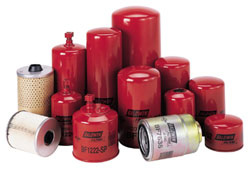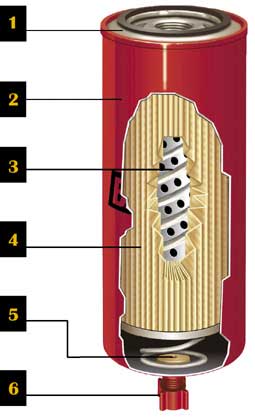| |
|
Ask the Expert - Fuel Filters
Dirty Fuel Is a Fact of Life
 We've heard all the stories about contaminated fuels. No. 2 diesel fuel is one of today's most variable fuel sources. Its quality and purity range unpredictably from very good to very poor. Current API specifications allow "acceptable" levels of impurities (sulfur and wax) and contaminants (dirt, ash, and water). It's likely that these regulations will weaken even further in the future. We've heard all the stories about contaminated fuels. No. 2 diesel fuel is one of today's most variable fuel sources. Its quality and purity range unpredictably from very good to very poor. Current API specifications allow "acceptable" levels of impurities (sulfur and wax) and contaminants (dirt, ash, and water). It's likely that these regulations will weaken even further in the future.
The deterioration of fuel is almost inevitable. Contaminants are introduced into the fuel system through mixing, transferring, and storage.
Micro-organisms Can Quickly Become Major Problems
Colonies of fungus and bacteria, both aerobic and anaerobic, feed on your fuel. Commonly known as humbugs, they spread rapidly in the presence of moisture. They ride along with the fuel, easily pumped from one tank to another. As the micro-organisms accumulate, they will spread through the fuel system and quickly plug the fuel filter. A coating of slime will develop over the entire surface of the media. Chemical treatment with a biocide is the only effective solution to the problem of bacterial and fungal growth.
Contaminants arrive in your fuel in two forms - precipitates and particulates. Precipitates are non-combustible materials formed when fuel oxidizes. They may also form if, as sometimes happens, two incompatible fuels are blended. Significant swings in temperature accelerate the precipitation problem. Because precipitates are generally heavier than fuel, they tend to settle to the bottom of tanks. Decanting or carefully drawing off the fuel will leave the precipitates behind. Particulates, sometimes called "asphaltines," are black, tar-like contaminants. A residue of the refining process, particulates plug filters quickly. There is no known chemical treatment for the removal of these contaminants.
Wax, in moderation, is a desirable fuel component. It adds energy to the fuel. In operation during cold weather, however, control of wax becomes necessary, usually by applying additives or changing to a higher grade of diesel fuel. Like water, wax begins to thicken at colder temperatures. As wax gels, it can restrict and eventually stop fuel flow. Wax thickening involves a couple of critical temperature points:
- Cloud point - the temperature at which solid crystals of wax begin to form - the fuel looks opaque, but it still flows.
- Pour point - the temperature at which the gel forms - the fuel cannot be poured.
Potentially the most damaging of the contaminants, water destroys the lubricative properties of your fuel. With lost lubricity, the fuel can scour pumps and even blow out injector tips. At colder temperatures, water in the fuel can freeze and contribute to total fuel stoppage. The good news is, water can be removed from fuel � within limits. There are three common mechanisms of water removal.
- Stripping - A silicon-treated medium inhibits the passage of water, but allows fuel to flow freely.
- Coalescing - Gravity drags water droplets (heavier than fuel) out of slow-flowing fuel.
- Absorption - A filter medium with a high affinity for water and a low affinity for fuel absorbs the water in the fuel.
Some OEMs use fuel/water separators relying on a stripping mechanism. Several difficulties occur with these separators.
- Plastic bowl separators are subject to road hazards and chemical attacks, resulting in cracks and leaks.
- Replacement bowls are not easily available, and the replacement process is difficult, increasing costs and downtime.
- The configuration of the plastic bowl creates an additional path for leaks.
Baldwin Fuel Filters Designed to Perform Better
Baldwin filters have been designed and tested to perform according to structural specifications for:
- Vvaried service environments.
- Expected service life.
- Flow requirements.
- Working and maximum pressures.
- Surges and fluctuations of pressure.
Baldwin filters have been tested against the constraints of SAE J905, the official standard for determining fuel filter performance. In each case, the Baldwin filter was asked to perform under:
- An accumulation of fine dust (particles 2 to 40 microns in size).
- A constant flow rate.
- A constant termination pressure.
- A constant temperature (100 degrees F.).
- A constant contaminant add rate.
These SAE specifications address the principal determinants of on-the-job performance:
- Efficiency in removal of contaminants.
- Capacity for removal of contaminants (as measured in holding capability of the media over the desired change interval).
- The filter's ability to meet needed flow rates for fuel.
Tank after tank, Baldwin helps your fuel flow freely. Dirty fuel can sap your engine's power and drain its longevity. It can rob you blind. Baldwin fuel filters protect your engine from the harmful effects of water and contaminants in fuel. Baldwin filters will pay for themselves many times over in increased engine performance and longer engine life.
See The Baldwin Difference

- Heavy-Duty Baseplate is joined to the can with a double-rolled tuck lock seam to resist leakage due to high pressure.
- Heavy-Duty, All-Metal Housing provides unequaled burst- and pulse-withstanding strength.
- Spiral-Seamed Centertube helps prevent collapse caused by a sudden difference between internal and external pressure.
- High-Efficiency HydroShieldTM Media repels water and other contaminants.
- All-Metal Self-Venting Drain eliminates the need to separately vent the fuel system prior to draining while adding superior structural strength and ease of service.
- Easy-Opening Valve has one seal instead of three and requires 88 percent less torque to open and close.
 back to top back to top
|
|
|


 We've heard all the stories about contaminated fuels. No. 2 diesel fuel is one of today's most variable fuel sources. Its quality and purity range unpredictably from very good to very poor. Current API specifications allow "acceptable" levels of impurities (sulfur and wax) and contaminants (dirt, ash, and water). It's likely that these regulations will weaken even further in the future.
We've heard all the stories about contaminated fuels. No. 2 diesel fuel is one of today's most variable fuel sources. Its quality and purity range unpredictably from very good to very poor. Current API specifications allow "acceptable" levels of impurities (sulfur and wax) and contaminants (dirt, ash, and water). It's likely that these regulations will weaken even further in the future.
